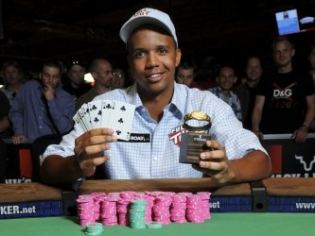
Last week, we told you about poker superstar Phil Ivey’s lawsuit against London’s Crockfords for the casino’s failure to pay him the £7.3 million he won over two nights at a high stakes punto banco table in August 2012. The UK’s Daily Mail originally reported the story of Ivey’s big score and Crockfords’ lack of payment in October and it was not until this month that Ivey decided to pursue legal action.
Now things have gotten even more interesting. Crockfords, London’s oldest casino, has issued a public retort through the Daily Mail, detailing how it believes Ivey cheated.
But first, let’s review the basics of the story. In late August, Ivey took £1 million to a high stakes punto banco table and began playing for £50,000 per hand, a limit that he was eventually permitted to raise to £150,000. He fell into a hole of about £500,000, but eventually climbed out of it, ending his first night with a profit of £2.3 million. The next night, he returned and went on another heater, winning £5 million.
When Ivey went to cash out, he requested that the money be sent directly to his bank account. Since it was a bank holiday in the UK, though, the casino said the transaction would not be able to be completed until the following Tuesday, August 28th. That was fine with Ivey, but when he left, the casino began an investigation into his possible cheating.
At the time, Crockfords produced no evidence of any wrongdoing. Genting, the casino’s parent company, flew in its own investigator who spoke to everyone present at the game, reviewed security footage, and examined the equipment. The report was that no cards were marked or otherwise tampered with, Ivey never touched the cards, and there was no collusion with any employees. The only thing reported at that time that was at all iffy was that Ivey was with a female companion who had had her membership to another casino suspended, but aside from that, there was no evidence against her in this situation.
Now, though, according to the Daily Mail story, Crockfords says it has evidence that Phil Ivey cheated his way to millions. The casino told the Daily Mail that flawed cards were in use at the table, allowing Ivey to know what was coming. According to Crockfords, the cards were mis-cut at the factory, resulting in the diamond pattern on the backs of the cards to be uneven. Normally, the diamond shapes would touch the edges of the cards perfectly, resulting in a uniform pattern and making the cards look the same no matter which way they were turned. With these cards, though, the cut at the factory split the diamonds in half on one edge, resulting in a non-symmetrical card.
To illustrate the importance of this, we must take a moment to give a brief summary of punto banco, a popular baccarat variant. In the game, two cards are dealt to the “Banker” and two to the “Player.” Tens and face cards count as zeroes and all others count as their respective numbers. The cards are added together and then the left-most digit is dropped to come up with a value (ex: 7 + 8 = 15, drop the 1 and the end result is a score of 5; K + 4 = 4, no need to do anything further). There are rules that determine whether or not the two hands are dealt additional cards, but that’s not important for the purposes of this article. Whichever hand comes closest to a final value of 9 wins. The player can bet on either hand; it makes no difference whether it is the hand belonging to the “Banker” or “Player,” except when it comes to payouts.
As one might guess, cards of values 8 and 9 are the most coveted cards in the deck. Ivey was allegedly on the lookout for these, as well as possibly 6’s and 7’s. According to Crockfords, when a key card was dealt, Ivey’s female friend asked the dealer to rotate it 180 degrees because Ivey was supposedly superstitious. The dealer didn’t see how this would give him an advantage, so he did it. There was an advantage, though, says Crockfords, as because the cards had the asymmetrical pattern, turning them 180 degrees made it obvious which cards were the ones Ivey wanted once the shoe was reshuffled. On top of that, Ivey asked the casino to “hold the shoe” when he retired the first night so that he could use the same cards the second night, again, a superstition thing. Normally, the cards would have been destroyed, but the casino allowed them to be held.
It is not known if Crockfords has solid evidence that any of this happened. As was mentioned earlier, in the original investigation, nothing odd was discovered, so it does seem strange that all this would come out now.
























Did Phil Ivey take advantage of a casino with flawed decks? Probably. The Casino should thank Phil for pointing out a problem with their decks. The fact that they continued to let Ivey play after winning is their fault. Does Phil Ivey lose some respect for this move? Probably.